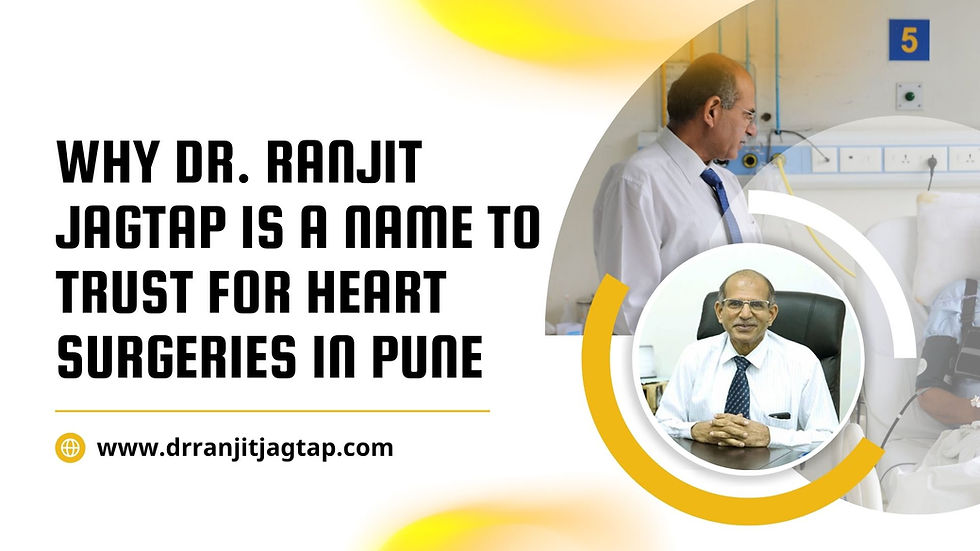Everything To Know About Blood Clots In Your Veins, Heart
- drranjitjagdap
- Jan 15, 2024
- 3 min read

When you cut yourself while chopping green-leafy vegetables, your body gets an immediate alarm to block injurious harm. Well how, let us learn! Your lovely blood cells team up to hinder huge streams of blood flow where it doesn’t belong! Overall this is categorized as clotting.
Well, to calm your heart! While clotting is a scary and trembling word for some, blood clots aren’t always clingy. They smoothly help in jumpstarting the healing journey. But from time to time, clots can form where they shouldn’t. When this happens, blood clots can break the flow of blood arising from a condition called thrombosis and results can be dangerous.
“Thrombosis is harmful because it can be hazardous for life” Says Dr. Ranjit Jagtap, an energetic cardiovascular and thoracic surgeon, with Ram Mangal Heart Foundation Pune. “If not long, try walking around the office desk, wearing tight clothes causes blood clots so wear comfortable lines,” says Dr Ranjit Jagtap.
According to the CDC, the exact number of people at risk of blood clots isn’t known, but it assumes that nearly 900,000 Americans tend to get affected each year.
Keep reading to extract information about blood clots, their potential risk and whom to reach out to.
Let’s Enquire What A Blood Clot Is.
When a blood vessel is injured, deriving from a cut, the damaged blood cells are dispatched to stop the bleeding. Platelets are the cells in our blood that respond to a message and get to work forming a clot.
The platelets transform from a liquid to jelly-like clots. They begin to attach one another to the blood vessel wall. Platelets grow long tentacles that appear like a net to capture and trap red blood cells. This response usually stops when the injury is overhauled and the body breaks down the clot.
However, when a clot is formed inside one of your veins and doesn’t dissolve, it can turn into a medical emergency.
Medical science says there are 3 types of blood clots in total, which are formed in your blood vessels, which are venous thromboembolism, pulmonary embolism, and arterial thrombosis.
Venous Thromboembolism (VTE)
This type of blood clot forms in the veins or arteries — most frequently in your legs, thigh, pelvis, etc. This is the case with DVT
Pulmonary Embolism (PE)
This type of blood clot happens when a clot breaks and travels to the lungs, blocking a little bit or all of the blood supply. For example: if a clot from your leg travels from your legs, such as DVT, travels to your lungs and blocks blood flow streams, your body cannot get the relevant oxygen and nutrients it needs.
Arterial Thrombosis
This case occurs in the blood vessels or arteries of the heart or brain.
“The clot in the blood usually happens due to plaque buildup leading to clot formation,” professionals at Dr Ranjit Jagtap Clinic say. The clot may stop the blood flow to the heart, which can cause a heart attack. When a blood ball forms in the arteries of the heart that feeds the brain, it can cause a stroke.
What Leads To A Risk?
Professionals atDr. Ranjit Jagtap Clinics says that older adults over 60 are at big risk for blood clots, but blood clots can happen at any age.
Risk Elements Include:
Previous History
Diabetes
Hypertension (High Blood Pressure)
Injury to a Deep Vein
Cancer
Smoking
Plumpness
Least to No Physical Activity or Longer Sitting Routine
Being stuck in bed or a chair
Have A Blood Clot Before
What Are The Symptoms Of A Clot?
Symptoms of leg clots include swelling, pain, redness or warmth.
Pulmonary embolism (lung clot) includes experiencing shortness of breath, sharp chest pain, cough or passing out.
For a heart clot, common features include extreme pain, heavy pressure in the chest and arm, shortness of breath and extreme sweating.
How are blood clots treated?
If we spot a blood clot in the leg or the lung, we typically have departments ranging from cardiology, radiology, pathology, cardiac rehabilitation, and pharmacy. Patients experience top-notch treatments from all areas. “We are an army of professionals trekking up to perform conducive surgery” Dr Ranjit Jagtap states. In some situations, we use suitable devices to remove the clot when it is causing life-threatening diseases. Our doctors perform the 12 most highly effective healing surgeries of all time. As long as your affectionate heart is kept with us, no threat can enter the edges of freedom.
Reach out to Dr. Ranjit Jagtap Clinic today, to check the malady of your heart. Personal appointments with professionals can reach solutions for you on time. Dr Ranjit Jagtap’s Daughter, Aditi Jagtap Pune plays a huge role as a fore-frontier in taking personalized care of potential heart patients across the foundation.





Comments